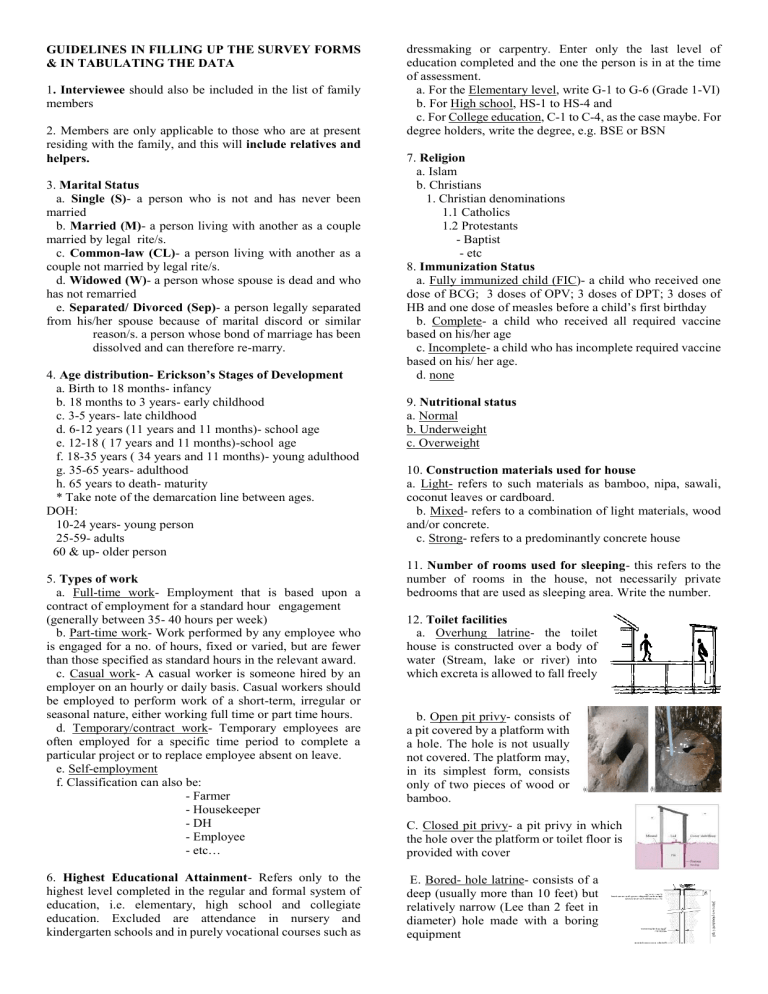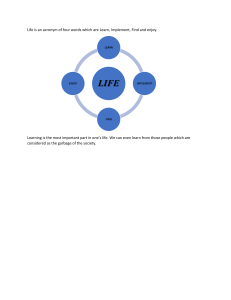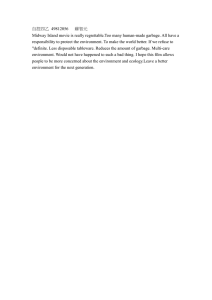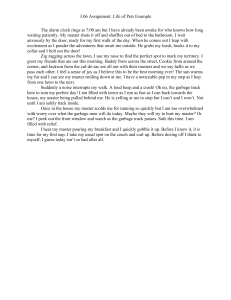
GUIDELINES IN FILLING UP THE SURVEY FORMS & IN TABULATING THE DATA 1. Interviewee should also be included in the list of family members 2. Members are only applicable to those who are at present residing with the family, and this will include relatives and helpers. 3. Marital Status a. Single (S)- a person who is not and has never been married b. Married (M)- a person living with another as a couple married by legal rite/s. c. Common-law (CL)- a person living with another as a couple not married by legal rite/s. d. Widowed (W)- a person whose spouse is dead and who has not remarried e. Separated/ Divorced (Sep)- a person legally separated from his/her spouse because of marital discord or similar reason/s. a person whose bond of marriage has been dissolved and can therefore re-marry. 4. Age distribution- Erickson’s Stages of Development a. Birth to 18 months- infancy b. 18 months to 3 years- early childhood c. 3-5 years- late childhood d. 6-12 years (11 years and 11 months)- school age e. 12-18 ( 17 years and 11 months)-school age f. 18-35 years ( 34 years and 11 months)- young adulthood g. 35-65 years- adulthood h. 65 years to death- maturity * Take note of the demarcation line between ages. DOH: 10-24 years- young person 25-59- adults 60 & up- older person 5. Types of work a. Full-time work- Employment that is based upon a contract of employment for a standard hour engagement (generally between 35- 40 hours per week) b. Part-time work- Work performed by any employee who is engaged for a no. of hours, fixed or varied, but are fewer than those specified as standard hours in the relevant award. c. Casual work- A casual worker is someone hired by an employer on an hourly or daily basis. Casual workers should be employed to perform work of a short-term, irregular or seasonal nature, either working full time or part time hours. d. Temporary/contract work- Temporary employees are often employed for a specific time period to complete a particular project or to replace employee absent on leave. e. Self-employment f. Classification can also be: - Farmer - Housekeeper - DH - Employee - etc… 6. Highest Educational Attainment- Refers only to the highest level completed in the regular and formal system of education, i.e. elementary, high school and collegiate education. Excluded are attendance in nursery and kindergarten schools and in purely vocational courses such as dressmaking or carpentry. Enter only the last level of education completed and the one the person is in at the time of assessment. a. For the Elementary level, write G-1 to G-6 (Grade 1-VI) b. For High school, HS-1 to HS-4 and c. For College education, C-1 to C-4, as the case maybe. For degree holders, write the degree, e.g. BSE or BSN 7. Religion a. Islam b. Christians 1. Christian denominations 1.1 Catholics 1.2 Protestants - Baptist - etc 8. Immunization Status a. Fully immunized child (FIC)- a child who received one dose of BCG; 3 doses of OPV; 3 doses of DPT; 3 doses of HB and one dose of measles before a child’s first birthday b. Complete- a child who received all required vaccine based on his/her age c. Incomplete- a child who has incomplete required vaccine based on his/ her age. d. none 9. Nutritional status a. Normal b. Underweight c. Overweight 10. Construction materials used for house a. Light- refers to such materials as bamboo, nipa, sawali, coconut leaves or cardboard. b. Mixed- refers to a combination of light materials, wood and/or concrete. c. Strong- refers to a predominantly concrete house 11. Number of rooms used for sleeping- this refers to the number of rooms in the house, not necessarily private bedrooms that are used as sleeping area. Write the number. 12. Toilet facilities a. Overhung latrine- the toilet house is constructed over a body of water (Stream, lake or river) into which excreta is allowed to fall freely b. Open pit privy- consists of a pit covered by a platform with a hole. The hole is not usually not covered. The platform may, in its simplest form, consists only of two pieces of wood or bamboo. C. Closed pit privy- a pit privy in which the hole over the platform or toilet floor is provided with cover E. Bored- hole latrine- consists of a deep (usually more than 10 feet) but relatively narrow (Lee than 2 feet in diameter) hole made with a boring equipment F. Water-sealed latrine- nonantipolo type of toilet, boredhole latrine or any pit privy wherein water- sealed toilet bowl is placed instead of the simple platform hole. SPOT MAP/ COMMUNITY HEALTH DATA SHEET(whole purok and per block) • Individual households, locations and distances from each other • Physical characteristics of the community such as: - waterways ( river, etc…) - land use (rice fields, etc) - Public service infrastructure (bridges, etc) - Non-residential structures (churches) - Boundaries of the purok - All types of water sources G. Flush type- a toilet system where waste is disposed by flushing water through pipes (sewers) into a public sewerage system or into an individual disposal system like an individual septic tank. H. Pail system- a pail or box is used to receive the excreta and disposed later when filled, this includes the “balot” system wherein excreta is wrapped in a piece of paper or plastic and thrown later. -The community health datasheet is like a spot map. It gives you an idea about the health status of families and guides community managers in planning projects needed by the community. -The health indicators are provided on the datasheet. The color coding stand for health status or condition of each household. i. Antipolo type- the toilet is elevated and the shallow pit is extended upwards to the platform (toilet floor) by means of a chute or pipe made of clay, metal, aluminum or board -The household datasheet. Individual presentation of every household presented as data matrices that contain information. - health programs (columns) - Colors in the cells (value-entry) 13. Storage of water a. large- contain 4 gallons or more 14. Drainagea. Open- waste water flows through a system of pipes (could be improvised from bamboo) to an open pit or canal b. Blind –waste water flows through a system of closed pipes to an underground pit or covered canal. c. None- water flows freely from source to the ground or thrown to the ground after being used. 15. waste disposal a. hog feeding- garbage is used as a hog fee b. open dumping- refuse and or garbage is piled in a dumping place (w/or w/o pit) with no covering C. Open burning- regularly piles refuse/garbage piled in a dumping place [w/ or w/o pit) with no soil covering then burns them D. Burial pit- refuse/garbage is placed in a pit and covered when filled up. There is no intention to dig it up later for use as fertilizer. E. composting- involves burying or stacking of alternating layers of organic-based refuse/garbage and “treated coil” arranged so as to hasten rapid decay and decomposition into compost. This organic mixture can later be used as fertilizer. F. garbage collection-refuse/garbage collected by garbage truck or any type of garbage collection in the community. REMINDERS: Survey forms • Submit with the list of households surveyed in alphabetical order • Arrange the forms per purok/sitio • Number the forms based on its number in the spot map • Summarize the data using the guide below No. Head of the Family Partner No. of children I P FP N W GD T Meaning of the colors: - Red (Stop, danger) - Yellow (needs improvement, caution) - Green (go, safe) - Blue (None, not applicable) The health datasheet keep an eye on at least seven(7) public health programs in the households of a community. This programs are the health indicators: - Immunization - Prenatal - Family planning - Nutrition - Water - Garbage disposal - Toilet COMMUNITY HEALTH PLAN AND GANNT CHART GANNT chart • Visual representation of a project schedule • A type of bar chart that shows the start and finish dates of the different required elements of the project • Typically, tasks are shown on the vertical axis, and the project time span on the horizontal axis • Each task has a corresponding bar that shows the time span required for the task • Developed by Henry Laurence Gannt, an American mechanical engineer Example of GANNT chart: Community Health Plan Example: Community Organizing Participatory Action Research Community Organizing Process by which health services, agencies, and people of the community brought together to: - Identify/learn their own problem - Plan activities - Act on this basis - Evaluate COMMUNITY ORGANIZING EMPHASIZE Strengthening the community members capability in: - Problem solving skills and - Decision Making skills (Necessary for self reliant development) Roles and Responsibilities of a Community Health Nurse Manager Guide Advocate Coordinator, Counselor, Change Agent Health Care Provider Nurse Trainer Researcher Organizer Leader Educator – Primary role, Primary responsibilities promotion of health and prevention of illness Supervisor Community Organizer Person who mobilize: Individual Family Sick or Well Community To come together in unity and collectively address given: Issues Needs Problem * assess by way of research PARTICIPATORY ACTION RESEARCH Is an investigation on problems and issues of the community by way of research. Representatives of community participates in the actual research. - Local Researcher - Outside Researcher = Community Health Nurse Act as researchers themselves, doing research of their own problem. The essential element of Participatory Action Research is participation Participatory Action Research Objectives: - To encourage consciousness of the suffering - To empower people to determine the cause of their own problem - To analyze these problem - To develop competence for changing their own situation - To act by themselves in responding to their own problems Ideal participatory research process involves the community in all research aspect 1. Identification of research problem 2. Formulation of research design 3. Data gathering 4. Validation of research 5. Data presentation 6. Recommendations 7. Action of activities COPAR Phase/Process PRE ENTRY PHASE At the NGO level - Formulation of institutional goals, objectives and targets for the program - Revision of curriculum - Training of faculty if CO-PAR - Coordinate participation of other departments within the institution At the community level - Community consultations/dialogues - Setting of issues related to site selection - Development of criteria for site selection Criteria in selecting community - Site must be - Depressed and underserved - Oppressed - Poor - Exploited - Struggling -Area must not have a serious peace and order problem - Willingness to be organized -Community needing health assistance * Check vital health statistic can determine general health status * Malnutrition rate * Lack of health facility/health care providers - Counter-part of the community (support, commitment, resources) - Accessible to transport and communication At the community level o o o Site selection Preliminary Social Investigation (PSI) Identify contact person Gather “overview” of the demographic characteristics, health services and facilities of the community Networking with LGU’s, NGO’s and other departments ENTRY PHASE Integration with the community main objective: Gain Trust First task courtesy call to the Brgy. Captain Establish rapport * house calls * joining to social activities Imbibe their lifestyle 5 M’S MANPOWER MACHINE MATERIAL METHOD Diria kay setting up lang, sa sustenance kay MONEY formalizing SPACE Setting up of linkages/network/referral system Immerse yourself Live with them Reside on the area * live in the center/modest dwelling • • • Sensitization of the community social preparation Information campaign on health services Continuing/deep social investigation - Process of collecting, collating, analyzing data to draw the clear picture of the community Core Group formation (CG) o Consist of identified potential leaders Characteristics of a potential leaders Respected community members Responsible/committed Willing to work for a desired change Has good communication skills Has wide “influence” to elite/poor community members Self-awareness and leadership training (SALT) Coordination with other community organization o Representing different sectors of the community 1. 2. 3. 4. 5. - SUSTENANCE AND STRENGTHENING PHASE Formulation and ratification of constitution and bylaws Identification and development of “secondary” leaders Setting up a financing scheme Continuing education and training of BHW’s Development of long term community health development plans Formalizing linkages, networks and referral system TURNOVER / PHASE OUT Transfer of community organizer roles and responsibilities and documents subsequent follow-up CO-PAR main goal is to attain COMMUNITY DEVELOPMENT BETTER QUALITY OF LIFE * Basic needs are met * Equal rights * Self-reliance * Active participation COMMUNITY DIAGNOSIS/STUDY PHASE (research phase) Selection of the research team Training on data collection Planning for the actual gathering of data Data gathering Training on data validation Community validation Presentation of the community study/diagnosis and recommendations Prioritization of community needs/problems for action COMMUNITY ORGANIZING / CAPABILITY BUILDING PHASE Community meetings to draw-up guidelines for the organization Election of officer Delegating key functions sa mga Development of management systems: leaders. (Delineation of the Roles, Function, and Task of Officers) Training of leaders Team building exercises to enhance cohesiveness Action-Reflection-Action-Session COMMUNITY ACTION PHASE Organization and training of BHW’s Village or Grassroot Workers PIME of health services Project Implementation/Monitoring and Evaluation (Project Management) Resource mobilization Dito mag-start na mag-act ang mga officers, and at the same time, ga-determine and train din sila ng mga BHW. May PIME na and ginagamit (mobilize) na ang resources





